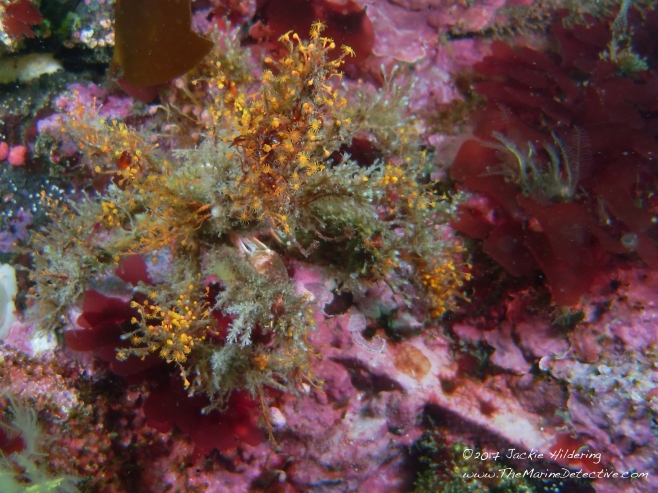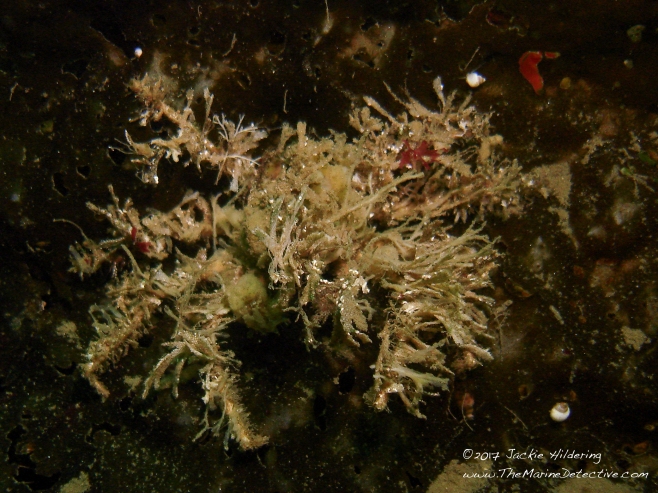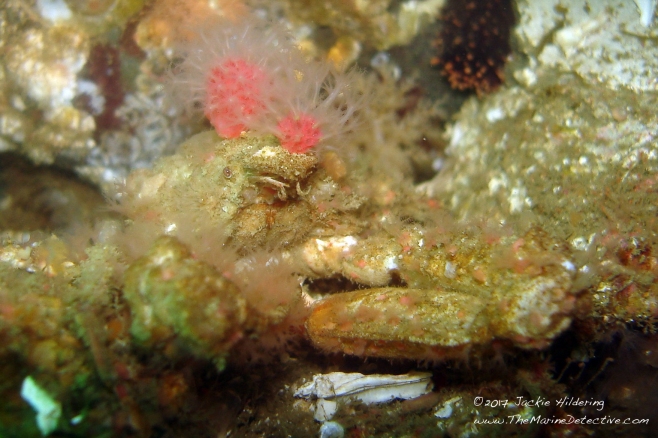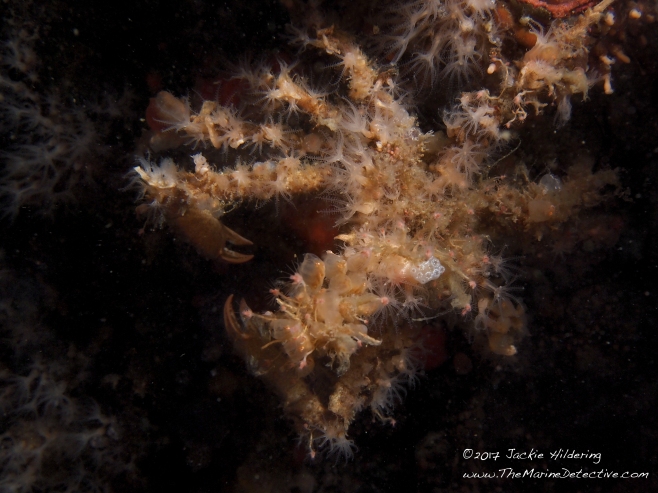Crabs Making Bad Choices
How do crabs make bad choices?
Let me show you via my photos and a “conversation” with the crab in the next three photos.

Oh hello mature male Sharpnose Crab. I almost didn’t see you there!
Please may I take a photo of how you have fabulously decorated yourself to camouflage against predators, using bits of algae, sponges, tunicates and hydroids?
It’s fascinating how your species, and others who decorate themselves, have little hooks (setae) on your exoskeleton to which attach life from around you AND that you change outfits when your change backgrounds. Do you sometimes also use the camouflage as easy-to-reach snacks?

Oh, oh! Wait!
You don’t know you are walking onto the head of a Red Irish Lord, an ambush hunter who is extraordinarily camouflaged too.

Careful! You are on the menu for this fish species.
The Red Irish Lord will try to grab you, ideally from the back of your shell. That’s what happened to the crab in the next two photos.


Indeed, that’s the same species of fish. Red Irish Lords have incredible diversity in colour to blend in so that you, and I, have great difficulty detecting them.
When the fish does not have the advantage of a sneak attack, you can defend yourself by spreading out your claws really wide. Like what you see below.
Then, it’s difficult for the Red Irish Lord to fit you into his / her mouth.


Yes, I too imagine the crab in the above two photos saying, “You want a piece of me?!”
It’s said of your species that you “put little effort into decoration”. Such judgement!
In another species, the Moss Crab, a correlation has been found between size and how much decoration there is. Once big, especially with claws spread wide, mature male Moss Crabs cannot easily be gulped up whereby there is less need for camouflage. But mature male Moss Crabs are huge! Up to 12.3 cm just across their carapace. Your species, the Sharpnose Crab (Scyra acutifrons) is only up to 4.5 cm across the carapace. Mature males of your kind have a far greater reach with their claws than mature females.
By the way what’s with the posturing with mature males of your kind when they do what is shown in the photo below?

Yours is NOT the only crab species that can be gulped up. I think it might be a Graceful Kelp Crab who has been engulfed by the Red Irish Lord below.


Below is another crab in danger of making a fatal choice as it advances down the face of the Red Irish Lord. See how precarious this is? The fish will remain motionless, waiting, waiting till you are in the ideal position to ambushed from behind. Then your claws are of little use to you.



There you go dear human readers.
I do not know the fate of either of the crabs on the heads of the Red Irish Lords. I had to return to the world where we humans can also make really bad choices.
Why no, my referencing human bad choices on November 4th 2020 is purely coincidental. Insert innocent eye batting here. What choices could I POSSIBLY be referencing? ☺️
Be kind. Be colourful. Be careful. Be truthful. Be safe. 💙

Regarding the photo above, see the Red Irish Lord and the two crabs with outstretched claws?
Related TMD Blogs:
Sources:
Drake, Catherine Anne, “Decorating Behavior and Decoration Preference in the Masking Crab, Loxorhynchus Crispatus” (2016). Capstone Projects and Master’s Theses. 74.
Jensen, Gregory. (2014). Crabs and Shrimps of the Pacific Coast: A guide to shallow-water decapods from southeastern Alaska to the Mexican border.
Wicksten, M. (1978). Attachment of Decorating Materials in Loxorhynchus crispatus (Brachyura: Majidae). Transactions of the American Microscopical Society, 97(2), 217-220. doi:10.2307/3225595













































